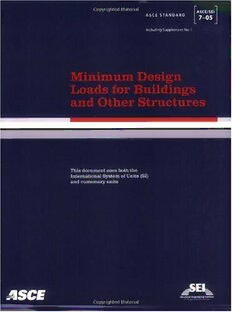
asce 7-05 minimum design loads for buildings and other structures PDF
419 Pages·2005·18.003 MB·English
Most books are stored in the elastic cloud where traffic is expensive. For this reason, we have a limit on daily download.
Preview asce 7-05 minimum design loads for buildings and other structures
Description:
The CD ROM version of the revised Minimum Design Loads for Buildings and Other Structures, ASCE/SEI 7-05 provides the complete text of the standard, including all figures, tables, and equations with all of the advantages of an electronic format: powerful text searches; download capability; multi-level bookmarks; and easy navigation. The new ASCE Standard 7-05 Standard (including Supplement No.1) provides requirements for general structural design and includes means for determining dead, live, soil, flood, wind, snow, rain, atmospheric ice, and earthquake loads, and their combinations that are suitable for inclusion in building codes and other documents. A detailed commentary containing explanatory and supplementary information to assist users of ASCE 7-05 is included. This ASCE 7-05 edition is a complete revision of ASCE 7-02. The new Standard includes revised and significantly reorganized provisions for seismic design of structures, as well as revisions in the provisions for determining live, flood, wind, snow, and atmospheric ice loads. The inclusion of Supplement No. 1 into ASCE 7-05 ensures that there is full and complete coordination between the 2006 International Building Code and ASCE 7-05. The updates which comprised Supplement No. 1 are seamlessly integrated into the 7-05 volume, and are not available anywhere else. ASCE 7-05 is an integral part of the building codes of the United States. The earthquake load provisions in ASCE 7-05 are substantially adopted by reference in the 2006 International Building Code and the 2006 NFPA 5000 Building Construction and Safety Code. Numerous other provisions of all other ASCE 7-05 sections are also adopted by reference by both model building codes including the provisions for calculating wind loads and snow loads. Structural engineers, architects, and those engaged in preparing and administering local building codes will find the structural load requirements essential to their practice.
See more
The list of books you might like
Most books are stored in the elastic cloud where traffic is expensive. For this reason, we have a limit on daily download.
